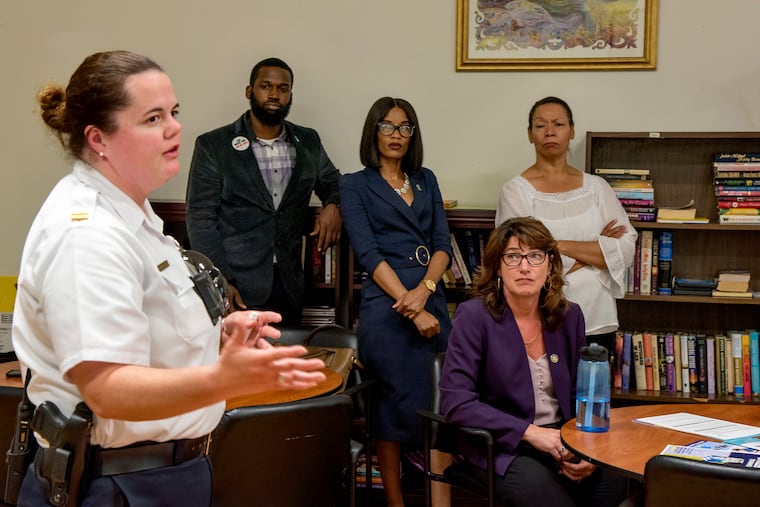Feeling helpless after getting catcalled? In Philly, there’s a training for that.
The training was born out of conversations on social media about a man lurking in Fishtown.

The Facebook comments were piling up.
A couple of months ago in a closed group for Fishtown neighbors, a woman posted that a man on a bike had leered at her, yelled vulgar comments, and followed her down the block.
Dozens commented to say they’d had a similar experience, with this man or another, in this neighborhood or another.
Summertime can feel like a sidewalk feeding frenzy for women subjected to crude commentary. Getting catcalled on the street isn’t a new phenomenon, but as cultural conversations around sexual harassment have become more common, so have discussions about how people (usually women) should respond to unwanted attention from strangers (usually men) in public.
So last week at the Lutheran Settlement House, State Rep. Mary Isaacson (D., Phila.), whose district includes Fishtown, partnered with educators from Women Organized Against Rape (WOAR) to host what they believe is the city’s first training session specifically for responding to street harassment.
“This is the first time we’ve really come out in public and talked about this,” Teresa White-Walston, WOAR director of education and training, told the dozen or so women and a couple of men who attended the training. She added that WOAR also plans to partner with other community organizations to launch a social media campaign, Safe Streets Philly, to further educate both victims and harassers.
Street harassment can be considered everything from catcalls and sexual commentary to stalking, flashing, and groping. Advocacy organization Stop Street Harassment conducted a survey last year, finding that more than three-quarters of women nationally said they had been subjected to some form of verbal harassment and more than one-third had experienced unwanted “genital flashing.”
It’s not clear how common an occurrence it is here. "Street harassment” isn’t a criminal statute (though aggressive behavior or physical contact can certainly be a crime), and catcalling and other verbal harassment isn’t typically reported to police.
The issue was taken up by officials in Philadelphia in 2013 when City Council held a hearing on street harassment at the request of then-Councilman Jim Kenney. Last week’s training marks new attention paid in the city to something experts say women too often push off as harmless, and then internalize.
“It’s usually just fear and uncertainty. My instant reaction is never to react,” said Ali Long, 23, of North Philadelphia, who attended the training. She said she’s experienced street harassment on a handful of occasions. “I’ve tried to explain it to guys a lot, and I think they’re sort of starting to get it. It’s not the comment. It’s how it makes you feel.”
Isaacson’s chief of staff, Samantha Pearson, said it’s happened to her: Someone makes a comment that makes her feel uncomfortable or unsafe, but she doesn’t know what to do, shrugs off the gesture, and moves on. She said her experience of feeling paralyzed isn’t uncommon, whether the harassment takes place on the sidewalk or the subway.
“[You feel like] ‘OK, I’m fine, nothing has happened.’ But something has," she said. "Those are the instances that people are not trained for. We push it away as bad behavior.”
So what should you do if you’re the person on the other end of that crass comment, or even just someone on the street walking by? If you want to respond directly and feel safe enough to do so, LaQuisha Anthony, of WOAR, said there are three steps to keep in mind:
Be firm and name what the person is doing. Consider something like, “Stop harassing me,” or, “That’s harassment.”
Don’t engage further, meaning, don’t go back-and-forth with the individual and escalate the situation.
Keep moving, she said, because “that person does not deserve your time or attention.”
White-Walston said when she’s catcalled, she responds: “Thanks, but no thanks,” and continues walking. If you’re not comfortable responding directly, she said, step into a nearby business and consider reporting the incident to police so they can either respond or at least take a report in order to track trends.
Philadelphia Police Capt. Krista Dahl-Campbell said that even if police can’t remedy the situation upon responding, they can learn more about hot spots for street harassment and set up patrols accordingly.
“The goal is not to tear our community down,” White-Walston said, “but people need to know this community is on alert.”
Levone Cannady, an education facilitator at WOAR who runs programming for men, explained that bystanders who witness street harassment have a variety of options. Here are some of his recommendations:
Ask the person who appears to be a victim if they’re OK or if they need help.
If you don’t feel comfortable being that direct, consider asking either person involved a question such as, “Do you know what time it is?” Or drop something on the ground near them to distract them. This short pause could give the victim time to regroup and plan an exit.
If you don’t want to intervene directly, find a safe place to observe. Your presence could deter the perpetrator further.
Police said to call 911 if the situation becomes physical.
Cannady said the best tool in combating street harassment is education — training sessions or public-awareness campaigns — for both women and men.
“This is not going to stop,” he said, “unless men have a firm idea of what boundaries are.”